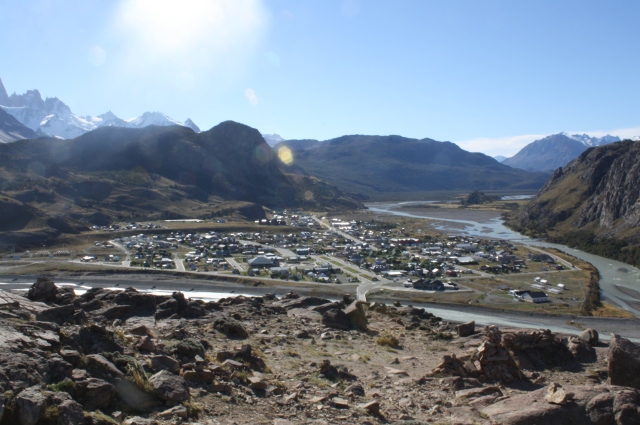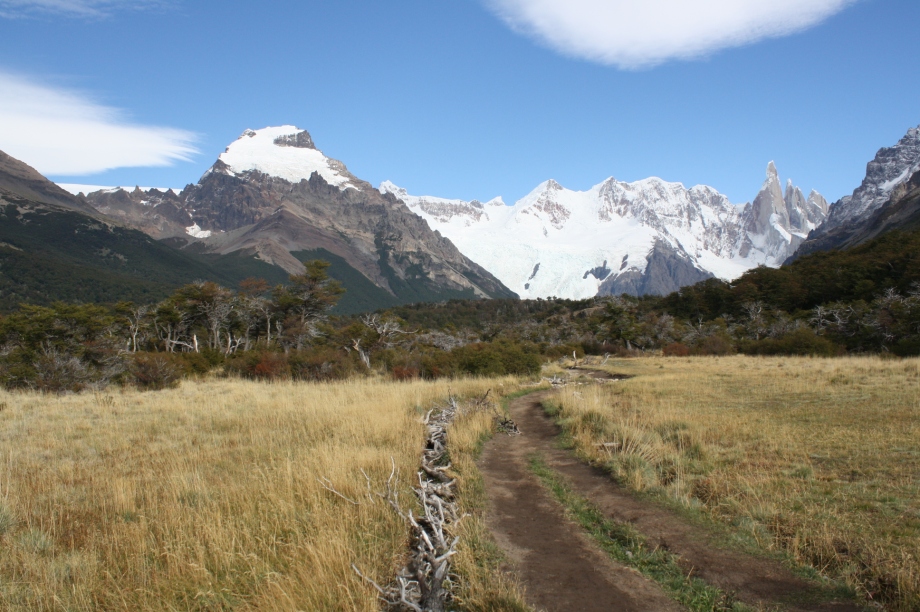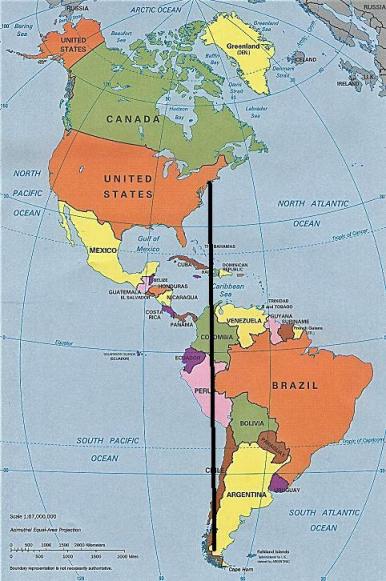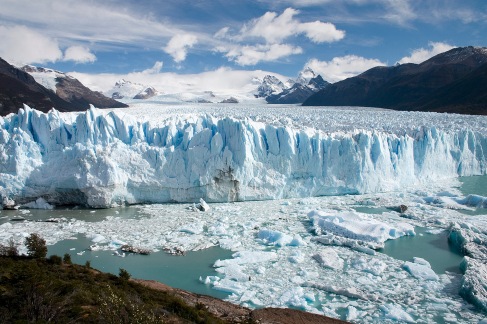Getting outside brings out the best of what’s inside you. When I’m surrounded by nothing but mountains, trees, and sky, I can’t help but feel like I’m more a part of the Earth. When I hike, I hike to be outside, to be captivated by nature, to experience the natural rhythm of life, to learn how to be more in rhythm with this rhythm, and to learn how to listen to the silence and sounds that are already there without me.
This wonderful mass of the universe that we live on is already moving, breathing, living, and functioning on its own, without us. To be able to experience that buzz of life without interruption and to really feel like a part of it all. That is why I go hiking. I experienced that and more the day we hiked the Laguna de los Tres route in Chaltén.
With our Backroads group we started the hike around 9 a.m. Four of us finished the hike around 9 p.m., completing a 12-hour hiking day, encompassing 13.4 miles while summiting a 4,000 foot peak. The day, exhilarating, overwhelming, and exhausting, was one of the best hiking days I’ve ever had.
Like almost all of the days on our trip, every element of the weather came together to be the perfect formula for a hike. The sky was clear; there was no wind; and the air wasn’t too warm or too cold (temperature in mid-50s to mid-60s). But don’t be fooled by this too-good-to-be-true weather report.
Travel Tip: With Patagonia weather, you never know what you’re going to get. Be prepared (both mentally and gear-wise) for high winds, frequent and unpredictable showers (rain or snow), and intense sunshine at any time of the year.
We hiked through forests, fields, mountains, and stopped along rivers and lakes. One minute we were enclosed by tree branches with only glimpses of sky and peaks. The next we were walking into a wide open field, sky stretching all around us, with low, scrubby bushes at our feet. The next we stood on top of a mountain with snow-capped peaks staring back at us. With each step, we experienced such vivid contrasts.
Laguna de los Tres, the lagoon of the three, is known as the best viewing spot for the Fitz Roy mountain range. De Los Tres refers to the three highest peaks you can see from the lake’s shore: Fitz Roy (11,073 ft), Poincenot (9,849 ft), and Saint-Exupéry (8,392 ft).

The peak above the man in the gray is Saint-Exupéry and then to the right there’s Rafael, Poincenot and Fitz Roy.
Fitz Roy is the highest spire in Argentine Patagonia. Even though it’s less than half the size of the world’s greatest peaks, it’s one of the hardest peaks to climb. The difficulty is part challenge and part unpredictable weather conditions. The area has also been pretty inaccesible until the more recent developments of Chaltén. Hundreds of people may reach the summit of Mount Everest in a day, but Monte Fitz Roy may only be successfully ascended once a year.
Saint-Exupéry is named in memory of Antoine de Saint Exupéry, a French aviator who delivered mail to Patagonia by plane in the early 1930s. He’s also the writer of the best-seller, “Le Petit Prince” (The Little Prince). He disappeared while flying over the northern part of Corsica. His death remains a mystery.
Poincenot is named after Jacques Poincenot, a member of the French expedition set to conquer Fitz Roy in 1952. While attempting to cross the Fitz Roy river, Jacques fell in and died. His team carried on and named the peak in his memory.
After about 5 miles of hiking through the forest and fields, we decided to power on for the climb to Laugna de los Tres. Up until this point the views had already been incredible. But it was about to get even better.
While mapping out the trail in the dirt with his hiking pole before our final steep climb, David, our local guide, said, “You’re going to arrive at a place where the mountains make you say, ‘Wow.’ If you don’t say that then you haven’t arrived.”
Once we reached the top we stopped to eat lunch. I wanted to stay there forever. Not only were the highest peaks in front of us, but behind us more mountains rolled on, fields spread, and the river snaked into the horizon. We were on top of the world. There’s nothing more rewarding than a view like that after a long hike and a steep climb.
As soon as we finished eating lunch, an avalanche erupted into the water. It was such a powerful booming noise. We just happened to be at the right place at the right time to hear it.
When we started to walk down one of the peaks, a cloud shaped like a halo formed over the peak in front of us. Once again we were in the right place at the right time. If you take the time and effort, the Earth will reveal its magnificence to you. You will be rewarded in ways you can’t even imagine.
To know that this will always be here- this all knowingness that the forest already holds, that the mountains already whisper, shakes me to the core in the best possible way. I’ve always felt another kind of spiritual presence in the woods and I could never really relate to that feeling with mountains, but on this day I did. Even just staring at them in the distance. Being surrounded by nothing else.
The rest of the Backroads group hiked ahead and David stayed with my Aunt, Susan and I. For the hike back, David was our personal tour guide. He stopped us every five minutes to teach us about our surroundings—why the clouds were shaped like they were, how the rocks formed, what happened to the trees, etc, etc. It was such an incredible way to experience hiking in Patagonia. David was so generous with his time, so extremely knowledgeable and helpful. He’s also an excellent photographer. You can view his pictures here.
We hiked at our own pace, taking our time to really absorb everything. Aside from taking pictures of every single thing I saw, I wanted to fully absorb my surroundings. I wanted to really look at things: pebble-sized rocks, skinny trees, huge mountains. I wanted to understand my surroundings as best as I could. I like to take my time, especially when I hike.
To observe is to truly be in the moment.
Some of our views on the hike back:
There’s a lot of useful information online about this hike if you’d like to take the same route.
How we did it:
From Chaltén shuttle 20 minutes to Hosteria El Pilar, a hotel 17 kilometers (10 miles) from town. Take the trail to the right of the Hosteria, keeping the river on the right. Continue straight; follow sign for Rio Blanco. After about 5 km you’ll reach a T-intersection. Turn right to pass through Campamento Poincenet. Turn left to go back to Chaltén. If continuing on, follow signs for Laguna de los Tres and Campamento Rio Blanco.
The hike back:
After climbing down the mountain, pass through a flat section of wetlands and wooden boardwalks. Turn LEFT at T-intersection toward El Chaltén and Laguna Capri. At next intersection veer RIGHT uphill and turn RIGHT toward Laguna Capri. Continue straight through Campamento Capri and follow signs for Chaltén.
And of course after the hike, don’t forget to stop in at La Cerveceria, a local microbrewery. A very rewarding stop after a full day of hiking.
Happy Trails!

































 Although I did get some knickknacks, I wanted to buy something that the locals bought. A real souviner to me is something that locals would also buy and use. If you’re looking for something like that then definitely check out the Paseo De Artesanos area on the main street next to the casino. Local artists open booths to sell their work. I bought a hair wrap and hand painted book mark here. My friend bought a mask made from a lenga tree. The only tricky thing is that there isn’t a set of hours they’re open. The booths are open whenever the artist feels like being there. Although they did seem to be open Friday and Saturday nights around 8.
Although I did get some knickknacks, I wanted to buy something that the locals bought. A real souviner to me is something that locals would also buy and use. If you’re looking for something like that then definitely check out the Paseo De Artesanos area on the main street next to the casino. Local artists open booths to sell their work. I bought a hair wrap and hand painted book mark here. My friend bought a mask made from a lenga tree. The only tricky thing is that there isn’t a set of hours they’re open. The booths are open whenever the artist feels like being there. Although they did seem to be open Friday and Saturday nights around 8.








